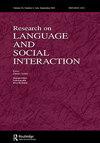序列促进:祖父母在视频通话中设计亲子互动
IF 2.1
1区 文学
Q1 COMMUNICATION
引用次数: 0
摘要
摘要完成一系列行动是参与者社会组织的一个基本问题。当第一对部分是针对尚未完全胜任的成员,如幼儿时,第三方可以通过不同的语言、体现和物质实践来促进序列的完成。在这篇文章中,我们在一个清晰的环境中研究了这种序列便利化:祖父母介导的中国流动父母和他们的留守儿童之间的视频通话。分析表明,序列促进的实践可以具有回顾性或前瞻性,不仅涉及语言实践,如重复父母的第一对部分或制定其动作,还涉及具体和物质实践,如定位相机或为孩子的身体设置物理动画。研究结果揭示了成人-儿童互动中相邻对的组织,以及它们在视频媒介交流中产生的具体和物质环境。这些数据来自四川和贵州的汉语方言。本文章由计算机程序翻译,如有差异,请以英文原文为准。
Sequence Facilitation: Grandparents Engineering Parent–Child Interactions in Video Calls
ABSTRACT Completing a sequence of actions is a basic problem of social organization for participants. When a first pair-part is addressed to a not yet fully competent member, such as a young child, a third party can facilitate the completion of the sequence through diverse linguistic, embodied, and material practices. In this article, we examine such sequence facilitation in a perspicuous setting: grandparent-mediated video calls between migrant parents and their left-behind children in China. The analysis shows that the practices of sequence facilitation can have a retrospective or prospective orientation and involve not only linguistic practices, such as repeating the parent’s first pair-part or formulating its action, but also embodied and material practices, such as positioning the camera or physically animating the child’s body. The results shed light on the organization of adjacency pairs in adult–child interactions and the embodied and material circumstances of their production in video-mediated communication. The data were in the Chinese dialects of Sichuan and Guizhou.
求助全文
通过发布文献求助,成功后即可免费获取论文全文。
去求助
来源期刊
CiteScore
7.30
自引率
7.40%
发文量
20
期刊介绍:
The journal publishes the highest quality empirical and theoretical research bearing on language as it is used in interaction. Researchers in communication, discourse analysis, conversation analysis, linguistic anthropology and ethnography are likely to be the most active contributors, but we welcome submission of articles from the broad range of interaction researchers. Published papers will normally involve the close analysis of naturally-occurring interaction. The journal is also open to theoretical essays, and to quantitative studies where these are tied closely to the results of naturalistic observation.

 求助内容:
求助内容: 应助结果提醒方式:
应助结果提醒方式:


